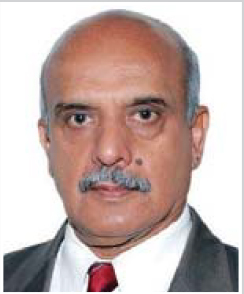Last month, the draft Electricity Amendment Bill, 2020, which pitches for some significant changes in the power sector, was made public by the Ministry of Power (MoP) for inviting comments from stakeholders. Power Line invited industry experts to express their views on the key provisions of the draft bill and highlight unaddressed issues. Excerpts…
What is your view on the draft Electricity (Amendment) Bill, 2020? What are the provisions that hold the most potential to reform the sector? Are there any unaddressed areas?

Anish De
Changes to the Electricity Act, 2003 have been put out in the public domain for comments. The current version was in the making for at least the past two years. Prior attempts did not see the light of day. The present changes are less ambitious and perhaps more implementable. Whether it is adequate to address the issues of the power sector is the moot question though, and answers on that are less than clear.
At the conceptual level, the proposed changes aim to bring in reforms by taking discretion out of the hands of states and utilities in areas where such discretion has affected the commercial construct and governance. The biggest change will come through the Electricity Contract Enforcement Authority (ECEA), which aims to address payment delays and defaults. This would have a huge impact because power purchase costs typically constitute about 80 per cent of discoms’ overall costs. If these can be contained, not only will the sanctity of commercial arrangements be restored, but there may also be significant improvement in commercial discipline.
A second key change proposed is to take away the discretion of individual states to select state regulators. Independent regulation was a fundamental premise of the Electricity Act, 2003 that never really worked at the state level. The proposed formulation of a common national selection committee for all regulatory functions is much better and implementable. There are a number of additional reforms proposed including transparent administration of subsidies through direct benefit transfer (DBT). There is also a thrust on the promotion of clean power. An attempt has been made to explicitly recognise distribution franchising as a means of better service delivery. A new concept of distribution sub-licensing has been introduced, but needs detailing.
The intent of the changes proposed is unexceptionable. The two questions that stick out pertain to adequacy and implementation. In terms of adequacy, it is noteworthy that some of the issues discussed in the past relating to markets, competition, efficiency, financial viability, sector restructuring, etc. are largely unattended in this draft. There is also an effort to push through changes through rules formulated by the central government, which may be contested.
The states are the major players in the electricity sector, especially in distribution. They would be the principal entities impacted by the changes. Hence, they would probably appreciate the logic, given their conditional resistance is only to be expected. They must be consulted in order to minimise any resistance. This brings us to the efficacy of the proposed changes. Given the deep-seated issues facing the distribution segment, these changes would probably be inadequate to turn the power sector around. With the economic effects of Covid-19 likely to continue, the capacity of the already bankrupt discoms to comply with the new requirements is uncertain. Hence, instead of trying to keep the sector structure and ownership intact, the need of the hour may be to bring in much more radical reforms that divest the state of ownership and bring in better governance and accountability. The ECEA, regulatory reforms and other measures proposed in the bill would arguably have a much better chance of success without the state being so deeply enmeshed in the ownership and operations of the power sector.

Dr Pramod Deo
The Draft Electricity Amendment Bill, 2020 has become a matter of debate and controversy across all segments in the power sector. Reportedly, the Telangana state cabinet termed it as a draconian bill and decided to strongly oppose it in Parliament. The draft bill has proposed to abolish state selection committees for appointing members to state electricity regulatory commissions (SERCs). It recommends their selection by a committee of the central government. The objection by state governments is understandable. Equally controversial is the proposal for the creation of an ECEA or authority to deal with contractual disputes between state discoms and electricity suppliers – generators and transmission entities. I propose to address this issue here.
This bill inter alia divests the electricity regulatory commissions (ERCs) of their dispute resolution function. The proposed authority would act as a central body with exclusive powers and jurisdiction to adjudicate upon the performance of service obligations under all contracts relating to the sale, purchase or transmission of electricity. It would not have any jurisdiction over any matters related to the regulation or determination of tariffs or disputes involving tariff. The authority would have at least five members of judicial and technical background appointed by the central government. All orders of the authority would be executable as a decree of the civil court. Appeal from its order would lie before the “restructured” Appellate Tribunal for Electricity (APTEL) and thereafter a second appeal before the Supreme Court.
Tariff fixation, a prime function of commissions, is akin to a legislative function as has been held by the Supreme Court in a catena of judgements. Commissions also make delegated legislation in the form of regulations on a variety of matters. The basic doctrine of our constitution requires separation of powers. From this angle, one argument in favour of the authority is that the power to legislate and the power to adjudicate upon disputes should not be vested in the ERCs as is the case today. Moreover, it is the perception of private investors in generation and transmission that in adjudication there is a tendency on the part of state regulators to take a “pro-revenue” approach when state utilities and state institutions are involved in a contractual dispute. With the combined functions of making legislation and adjudicating disputes, an ERC may assume the role of a judge in its cause. Technically, ERCs can make regulations and directly nullify a decision rendered in a specific dispute. A regulation may also overturn a decision of APTEL. Hence, ERCs can remove the basis of a decision in adjudication by simply altering the legislation. It can be argued that the objective of the ECEA is in effect to prevent the abuse of power. However, dispute on the jurisdiction of the ECEA or ERCs cannot be ruled out. Decisions involving a contractual dispute would receive finality only before the Supreme Court, entailing several years.
As per the Constitution of India, electricity figures as item 38 in List III (Seventh Schedule) or the Concurrent List, and is administered by both the central and state governments. No doubt, state governments view the proposed amendment as violation of the “basic structure” of the Constitution. So, what is the way out of this impasse? While the EA, 2003 itself entitles ERCs to either arbitrate or to refer disputes for arbitration. If it is made mandatory for commissions to refer contractual disputes for arbitration, the objectives of setting up the ECEA could be achieved.
The grounds for challenging an arbitral award were significantly narrowed down in the 2005 amendment to the Arbitration and Conciliation Act, 1996 and does not entail a review on the merits of the dispute. The mandate of the Supreme Court that there must be a judicial member in the adjudication of disputes can be easily complied with by having a person of legal background or a retired judge in the arbitral panel. The Arbitration Act mandates the passing of the final award within 12 months. The parties to the dispute are entitled to appoint their nominee who in turn would appoint the presiding arbitrator. Commissions would benefit as they would have much more quality time to address the various nuances and obligations of tariff determination, critical questions of cross-subsidy, agricultural metering etc. and promote the development of a market for ensuring cheaper electricity for consumers. All in all, referral of matters for arbitration will be a win-win situation for all stakeholders in the power sector. This will no doubt meet the central government’s principal objective of protecting the interests of generators and transmission providers through payment security.

Ajay Mahajan
The enactment of the EA, 2003 brought about a paradigm shift in the Indian power sector. It consolidated various electricity laws, ushered in competition and helped attract the much needed private capital in the power sector. It introduced new concepts such as open access, multiyear tariff (MYT), and the constitution of appellate tribunal for transforming the sector. While the majority of the sections have been enacted and yielding results, there are a few sections that are yet to be enforced fully. Further, although the act succeeded in many of its objectives over the past two decades, the need was felt to bring about amendments to address various issues affecting the power business in India and to further promote investments in the sector. In this context, the draft Electricity (Amendment) Bill 2020 is a welcome step and shall provide the much needed course correction in the power sector.
While all the provisions incorporated in the draft bill aim to address the various issues impacting the power sector, a few of them clearly stand out. These provisions pertain to the setting up of the ECEA, the determination of tariff by an appropriate commission without accounting for any subsidy and the inclusion of distribution sublicensees and franchisees. Each of these provisions tries to address issues that have majorly affected sector performance and investor sentiment.
Setting up of the ECEA: Although EA, 2003 had provisions related to the sale and purchase of electricity, it was lacking in terms of provisions related to issues under power purchase agreements (PPAs). The draft bill aims to address such gaps and proposes to create the ECEA to deal with the enforceability of PPAs and contracts for the transmission of power. This provision assumes significance in light of the situation created in the state of Andhra Pradesh with the change of government last year.
Subsidy accounting for tariff determination: The amendment bill proposes that subsidies should not be accounted for to determine the retail tariff, and subsidy, if any, should be given by the state government directly to consumers. This provision paves the way for DBT in the power sector and shall have far-reaching implications for the distribution segment, given that most discoms suffer from cash flow-related issues due to delays in the release of subsidy by the government.
Inclusion of distribution sublicensees and franchisees: Often, the weak financial profile of discoms restricts their ability to spend on capital works and upgrade the distribution infrastructure. The draft bill proposes to introduce the concept of “distribution sublicensee” (post the approval from ERCs) who would distribute electricity in the area of the existing distribution licensees. While the draft bill needs clarity and raises questions if the DSL would have dual jurisdiction of distribution licensee and ERC, or like a normal subcontractor, the DSL would be guided by performance parameters brought out in its agreement with the licensee. It, however, appears that the distribution licensee would be accountable for meeting the service standards in its area of supply and his agreement with the DSL with back-to-back service standards built in would ensure accountability of DSLs. The distribution sublicensee is not required to obtain a separate licence from an SERC. The said provision shall ease the burden of the distribution licensee and promote some specialisation apart from attracting private capital in the power distribution business. The draft Electricity Amendment Bill, 2020 is exhaustive and fulfils the unfinished agenda of the EA, 2003 apart from addressing the critical issues currently faced by the sector. It has, however, steered clear of controversial topics such as separation of carriage and content, which perhaps has the potential to revitalise the moribund power distribution segment. The distribution segment is the weakest link in the power value chain and has received multiple bailouts over the past two decades. The biggest reasons for discom inefficiency are political interference, corrupt practices on the ground, pilferage of power, the absence of cost-reflective tariffs, continuous losses constraining discom ability to spend on capex, among others. The separation of carriage and content may address part of this problem with the carriage part remaining with state entities and the content part being handled by private parties, thereby ushering in the much needed investment in technology and infrastructure in the power distribution segment and leading to a win-win situation for all.

Sanjeev Seth
The draft Electricity Amendment Bill 2020 is a much needed legislation to reform the sector. The key amendments proposed are promotion of renewable and hydro power; power distribution segment reforms; better governance of the power sector; enforcement of commercial contracts; tariff principles and rationalisation; and centralisation of appointments of chairman and members of SERCs.
Preparation of National Renewable Energy Policy: The preparation and notification of the National Renewable Energy Policy is a welcome step. It will spur investments in the hydropower and renewable energy sectors. Investment in hydropower will smoothen grid operations. However, the National Renewable Energy Policy should consider state-wise constraints of energy mix, renewable energy resource availability, consumer mix, demand profile, etc. The enhancement of penal provisions proposed in the amendments need to be reviewed in view of the liquidity constraints faced by discoms.
Creation of distribution sublicensees: A new entity in the form of a distribution sublicensee, which would function under a distribution licensee but would need to be approved by the SERC, has been proposed. However, further details regarding the structure, functions, duties and responsibilities are awaited. The provision of regulatory approval makes DSL more independent and is expected to provide more legroom for operations which were hitherto not available with the distribution franchisee. Private participation in the power sector will help state discoms to focus their investments in priority areas such as network upgradation and transmission evacuation. Previous privatisation and various distribution models, for example-public private partnership, private licensee, parallel licensee or franchisee, have already demonstrated success in the country. In our opinion, a few anomalies in contracts/bids or agreements could have been addressed for long-term success, thus helping to attract private players.
Further, a distribution franchisee is appointed by the SERC, which provides regulatory oversight. A hybrid distribution franchise model based on regulations can be explored in this case. Enabling cross-border electricity trade will also help in better utilisation of the surplus power generated in the sector. The role of the National Load Despatch Centre (NLDC) has been clarified and enhanced with the 2005 notification being made into a law. Also, for bringing in commercial discipline in the sector, the mandate for regional and state load despatchcentres to ensure that the payment security mechanism is in place prior to scheduling is a welcome step. However, it should be applicable on current dues rather than arrears.
The creation of the ECEA would help in resolving contractual disputes between entities in the power sector, and de-clog the courts and SERCs/the CERC/APTEL, etc. However, the creation of the ECEA would lead to the dilution of SERCs/ CERC/APTEL, as it would deal with only tariff-related matters. State discoms and state governments may oppose this amendment.
Chairman and members of SERCs/CERC have been proposed to be appointed by a joint committee of the central and state governments. This being an ingress on the state’s authority, the opinion of state governments must be awaited. Letting SERCs declare electricity tariffs without accounting for subsidy from state governments would help them in quick tariff determination. The discoms will charge consumers as per the tariff determined by the SERC and the subsidy will be directly transferred to a consumer’s account by the state government.
The creation of distribution sublicensee with regulatory oversight and control promises to be the most potential reform as it would enable more independent private sector participation in the sector. It has the potential to bring in private sector efficiencies to government discoms and reduce the burden on state governments of funding the power distribution segment.
The determination of tariff without subsidy by SERCs, charging of consumers as per the SERC-determined tariff by discoms, and the direct transfer of subsidy to consumers’ accounts are all welcome steps. The act was expected to make it mandatory to either appoint a distribution sublicensee or a distribution franchisee if AT&C losses are above a threshold, that is, above 20 per cent in a particular area, rather than having a government advisory for such an appointment. This would have provided for a better legislative framework for reforming the sector.


Daljit Singh and Dr Rahul Tongia
Much has changed in the power sector since the EA, 2003 came into effect 17 years ago, and the legislative framework needs significant changes to make the power sector future-ready. Otherwise, we will be addressing “yesterday’s problems”. It is worth pointing out that many of the issues addressed in the amendments, such as subsidies or the sanctity of contracts, did not require amendments. Instead these should have been addressed through the original act (which proposed a reduction in subsidies) or under a regular contract law or through regulatory frameworks.
The approach underlying the proposed amendments pushes for much greater centralisation, and relies on laws, rules and regulations with penalties for non-compliance. Given the federal structure of the country and with power being a concurrent subject, such an approach is not likely to succeed, as experience has shown. These amendments could even lead to newer distortions in the electricity markets as states, in order to avoid action by the ECEA or the NLDC, show a preference for state-owned plants. Such preferences could further compound distortions between publicly owned plants and private plants, or coal plants and renewable energy plants.
Many of the problems plaguing the power sector are political in nature, and the solutions also need to be political. Therefore, instead of a coercive approach, a methodology based on cooperative federalism with negotiations and discussions between the centre, states and consumers is more likely to be successful. This will not be easy and will require great effort by the central government. The current system with its diversity, which can at times be frustrating, does have benefits. It allows various states to experiment with different approaches to tariff setting, the structure of the sector, ownership patterns, etc. The tariff applicable within a state has been under the purview of the respective SERCs, but these amendments appear to give overriding power to policy notifications such as the National Tariff Policy (NTP). Effectively, this seems to give the power of legislation to the NTP without it having undergone legislative scrutiny. Depending on the specificity in the NTP, this could be challenged by states.
The proposal for an ECEA and a single selection committee for members and chairpersons of SERCs are indicators of the centralising tendency of the proposed amendments. Rather than creating new institutions such as the ECEA for each new problem, it is better to strengthen the existing institutions. In that context, the proposal to enhance the strength of APTEL is welcome. Furthermore, the ECEA focuses on helping generators, which is important. However, it raises the question on how we can solve problems at one end of the chain without solving problems at the other end, that is, non-payment to discoms. It is worth noting that the largest defaulter is the government, defaulting on both dues for its own power consumption and timely payment of subsidies.
Having a single selection committee would give too much control of the entire power sector to the centre. It might result in the appointment of members of the SERCs who are loyal or beholden to the centre, without directly addressing issues of skill sets, expertise, etc. Over the years, concerns have been raised about the lack of diversity in the composition of SERCs and the lack of younger people with domain expertise. Having uniformity in the selection process is likely to lead to even greater uniformity in the type of members and chairpersons of ERCs. Furthermore, a single selection committee may not be able to ensure that SERCs are peopled with individuals with objective power sector expertise and a thorough knowledge of local concerns. The amendments also do not address the issues of independence and skills of staff.
Another striking aspect of the amendments is the emphasis on targets. We believe targets are useful, but proper frameworks are even more important. Renewable purchase obligations (RPOs) for hydropower are not necessary because hydro is a mature technology and does not require RPO support to promote its use. The amount of hydro that a discom selects should be part of its resource plan. A well-developed resource plan should include an optimum amount of hydro based on cost, requirements for ramping, etc. This would naturally depend on the load pattern and resource mix of a discom, and is likely to be different in percentage terms for each discom. If hydro is not asked for enough by states, one reason is the lack of proper signalling, such as time-of-day pricing, or valuing non-kWh characteristics sufficiently. Today, we are obsessed about the levellised cost of energy, instead of applying a portfolio approach. Rather than specifying an RPO for hydropower, there should be a push for the least social cost planning by discoms. Instead of supply-side targets in terms of MW even for solar, there should be goals for reducing overall emissions. This would spur investments in energy efficiency, demand response, etc. as well.
The proposal to reduce and ultimately remove cross-subsidies and instead provide subsidies through DBT is a good idea. Currently, a high level of cross-subsidy in retail tariffs leads to high industrial tariffs, making it difficult for our industries to compete internationally. This also makes industrial consumers more prone to exit the system either through open access or self-generation, specially using renewable energy. In addition, providing electricity at subsidised rates leads to its inefficient use because the consumer does not get the correct price signal. DBT can help remove the incentive to overuse electricity, and if implemented correctly, it can lead to win-win outcomes with consumers also saving money. However, the implementation of DBT is not a panacea and raises several challenges. For those living in rented homes, the electricity bill is usually in the name of the landlord, and therefore, the direct benefit would go to him and not the tenant. A similar problem can occur for farmers who plough someone else’s land on contract or on a sharing basis. State governments often are very tardy in making payments. Therefore, a consumer may pay the full bill but not get the benefit (subsidy) from the state government until many months later. Also, some states may not have the resources to pay consumers directly. Currently, such states manage their discoms through innovative financing and only periodic payments. Further, determining the amount of subsidy (or direct benefit) may not be easy. To encourage efficient use of electricity, DBT should not be based on actual consumption of a household but on a normalised level of consumption. However, this normalised level will need to be calculated for many different types of dwellings which may be difficult, particularly at the start of a DBT programme.
The removal of cross-subsidy and the shift to DBT will be resisted very strongly by various states and consumers. In the past, farmers in some states have even resisted having meters put on their connections, even though they were told they would not have to pay. How can one determine appropriate levels of DBT for farmers without metering? Supply to such users is ostensibly standardised but, in practice, can sometimes be ad hoc or even political. Moving to DBT would require negotiations, dialogue and trust-building based on principles of cooperative federalism. There would be great resistance if, instead, the centre relies on rule by diktat.
Before the full-scale implementation of DBT, there will need to be several pilot projects to understand the issues involved and the responses of consumers. The people most affected by DBT are likely to be the marginalised and those with very limited resources. These same folks are the ones least likely to have the trinity of JAM (Jan Dhan bank accounts, Aadhaar, and mobiles). It is very important that we remember the lessons from the experience of migrant workers during the Covid-19 lockdown.
The amendment proposed regarding introducing distribution sublicensees needs greater clarity. The statement of objects and reasons states that it is an enabling provision to address issues related to Sections 126, 135 and 165 of the EA, 2003, when a licensee distributes electricity through another entity. Section 126 deals with assessment and enforcement associated with the unauthorised use of electricity. Section 135 deals with theft, and Section 165 deals with land acquisition by entities that are not companies. It is not clear what kind of enabling framework the introduction of a sublicensee would provide on any of these issues.
The MoP should explain the purpose of introducing sublicensees, what kind of enablement is being sought and why. It should also explain the reasons for the subtle differences between sublicensees and franchisees. Last year, there were reports of the MoP wanting to introduce retail competition with multiple franchisees and also talk of a national discom. Is the introduction of a sublicensee related to those ideas? Is the introduction of a sublicensee a first step in introducing retail competition or perhaps privatisation? It would help stakeholders have more clarity if the rationale is transparently conveyed. In addition to the issues above, there are a few smaller suggestions for the government. Technology is evolving rapidly, and the government should proactively facilitate the enablement of innovative technologies such as storage- and edge-based transactions. For example, it took a notification to clarify that EV charging stations were licence-free activities.
Almost paradoxically, this is a good opportunity for the more comprehensive and holistic rethinking we recommend. States and their discoms are going through a difficult time due to the Covid-19 pandemic, with hits to both operations (demand) and finance (cash flows). While the draft amendments, if implemented now, may help some aspects of the electricity value chain, these would exacerbate a number of issues for states and their discoms. Instead, this time can be utilised to build consensus and develop a blueprint for a power sector that is future-ready.
